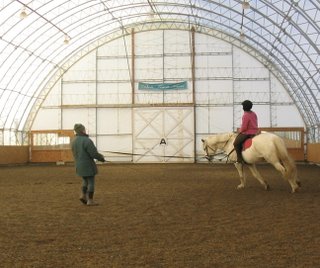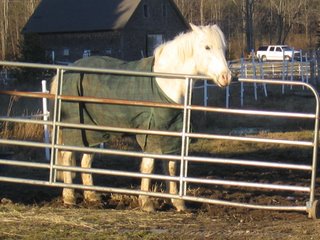
I am very pleased I arranged to have a lesson at Photo Finish Farm, and especially grateful for the surprise offer by my friend GS to ride her horse in the lesson.
It was a lunge lesson so control of this lovely fellow was primarily in the hands of RC, as I wanted. I tend to spend most of my energy attending to how the horse is doing, what the horse is thinking and feeling, what the horse might be doing next, and lose track of what my body is doing, so this lunge lesson was time especially for me to focus and learn about my seat and balance.
Wonderful lesson. Yes, I still hurt in some previously underused and slightly shortened/tight muscles, but I was able to come home and practice -- on my lovely but basically undisciplined horses -- some of the positions, motions, and stretching exercises she introduced.
RC helped me get my legs underneath me. Considering I ride in an expensive 'balanced seat' custom western saddle, I was surprised how much effort was required to have my legs well under me, sufficiently to make standing in the stirrups an upward motion instead of leaning forward and upward motion.
She gave me some of the exercises I watched GS do in her lesson before my lesson. Swinging leg back, one at a time, while staying securely connected through the seat bones (opens the hips, increases control of leg activity); standing in stirrups up on toes, then release the ankle joints, then the knee joints, then the hip joints to settle in the saddle again. This is ideally hands free, at walk, then at trot, and I suppose at canter although I didn't try that.
Identifying where the horse's feet are at every foot fall is central to RC's teachings. I'm grateful I've spent time getting that integrated into my every moment of riding, although she helped me with the timing of asking for canter depart.
The biggest 'aha' was using my hip angle to influence the speed of the horse. What she taught worked, which was to be up on my seat bones and tilt them one direction (upper hips back, lower hips forward) for more energy/speed, and tilt them the other direction (upper hips forward, lower hips back) for slow and stop. This is opposite from what I had learned somewhere along the line, and I can recall hearing the instructions "sit back on your pockets" for a stop. What I don't know for sure is how much it becomes what a horse acclimates and adjusts to, versus it is the 'right' way and what I had learned before was 'wrong' and therefore confusing to a horse. I have also heard that a horse will try to get his body centered under the rider, so if I were to tip forward, the horse would be inclined to move forward to get under me. Then I think, if I'm really balanced on the A/P (anterior/posterior) plane, then using the hip tilting is a very small, efficient way to communicate, although the explanation led me to be thinking about energy, not physical balancing.

I think this was my first cantering, before RC helped me understand and feel how I tightened my legs when cantering. It was awesome to feel my legs (hip leg joints) moving with the canter on our next canter. Now at home I can continue to experiment with all of my leg joints moving with the canter motion.

Will remained mentally connected as we prepared to leave.
My experimenting yesterday with my two Morgans led me to think it makes sense to them, however they are both pretty in tune with my intention and my energy output (life up, life down) so I don't know how much they were responding to my hip angle versus my energy and intention. Fun to play with though, and certainly important in my opinion to get control of all those lovely little and big muscles that control my lower torso.
It was a treat to ride a horse who was willing to trot for the majority of a 45 minute lesson! Gave me some motivation to expect more from my horses, and indeed, yesterday's ride provided more 'trot work' in the arena than I usually ask for.
It was a fun challenge to ride a 'lunge lesson' on a horse without someone to lunge us! I approached it with reins knotted safely on the neck, and used them only when a bit of steering would keep us out of trouble. (Picture me on one horse and the other horse free in the arena.) I was more able to practice and experiment with Kacee who offers more life and is more comfortable/willing/trusting? to trot around than Rusty is. I'm still fine tuning my assessment skills regarding Rusty's holding back.
I suspect it's a learned response to my past worry about too much life, so although it's a fear thing (he's afraid because I'm afraid), I think I can address it differently than if he was afraid of crossing a wooden bridge. And I have to constantly monitor MY level of trust with each horse, wishing to really limit -- eventually eliminate -- the hesitancy I add to our rides due to my lingering thoughts about something scary that may have happened last month or last year.
In any case, I look forward to more equitation lessons, and would embrace another opportunity to learn from RC and be accompanied and supported by GS. Something new to look forward to on my next trip(s) to Maine.
1 comment:
Well, I love reading this recount. Especially as it reflects so much of what I learn adn even how I learn. When you rode, your words and responses were pretty darn similar to what mine are sometimes.
Regarding the use of pelvic angle for energy. I believe this is physiologically/ boimechanically helpful to the horse. When you tilt the pelvis forward to slow the motion or to halt, I think it actually puts the brakes on. Picture yourself (xray view) on a horse. Tilt forward and feel/ see how that offers a closed door to the forward motion. Tilt back and feel how it opens the door in front and in fact pushes the energy forward. Try it on a stool or an exercise ball and go back and forth, eyes closed. Eventually, you can feel the door opening and closing with the angle of the pelvis. I think part of the trick, though is closing ONLY that angle. You isolate that part of your body and maintain your upperbody without tilting forward, esp as that will unplug your seatbones.
I believe horses WILL respond to however we teach them. So if we have always sunk onto our back pockets for stop, they'll oblige. I like this other way, myself, because I think not only can they become habituated to respond in the way I want but it makes logical body sense to them...
Grab straps are da bomb. I have heard that even the olympic riders will occasionally grab strap and hold on if a horse becomes particularly fractious. I also like that if my seat is not as consistent as I hope, which leads to my hands not being consistent, I can hold the strap and avoid bumping them in the mouth. It's a little crutch until my seat is completely independent. ;)
Post a Comment